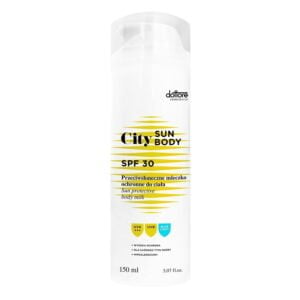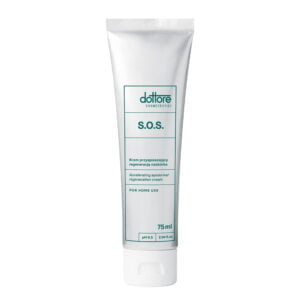Burns – how to deal with them?
What is the difference between a sunburn and a 2nd degree burn? Find out how to recognize the degree of a burn and how to treat burned skin.
Spis treści
When are burns dangerous?
A burn is called damage to the skin (and sometimes deeper tissues) under the influence of high temperature, sunlight, electricity or corrosive chemicals. Light burns are harmless, but they are accompanied by unpleasant and persistent symptoms. The result of improper care of burned skin can be undesirable aesthetic effects. For more serious burns, it is essential to contact a doctor immediately. Extensive, intense burns can even threaten the health and life of the affected person.
Today we will look at 1st degree burns, which are the lightest ones. In order to effectively deal with skin burned by the sun or hot water, for example, one must first learn to recognize the degree of the burn.
Types of burns
Burns are divided into three types (degrees) based on their severity. Each degree of burn has characteristic symptoms.
1st degree burn
The most bothersome with this degree of burn is a painful burning sensation. The skin is red and very tender. There may be a slight swelling. Symptoms disappear after a few days and usually leave no marks or scars. Sunburn may be accompanied by peeling of the top layer of the epidermis as it heals.
2nd degree burn
In addition to 1st degree symptoms, there are blisters filled with serous fluid. The fluid becomes visible between the epidermis and the dermis border and acts as a natural dressing. Second-degree burns take about 2 weeks to heal. After the healing process, scars may remain on the skin. However, this depends on the individual ability of the epidermis to regenerate and the management of the burned skin.
3rd degree burn
This is the most dangerous degree of burns. It occurs, for example, under the influence of an open flame. The damage extends to the deep tissues. Wounds appear on the surface of the skin, in addition to grade 1 and 2 symptoms. In extreme cases, necrosis, or tissue death, occurs (this condition is sometimes called a 4th degree burn).
Burned skin – what to do?
In case of a burn, the most important thing is to immediately stop skin contact with the heat source. Then pour plenty of cool running water over the burned area – even for several minutes. This helps stop the deepening of the burn and provides relief from the burning pain.
The effectiveness and speed of healing of burns depends on how quickly and how properly first aid was administered. Importantly, 2nd degree burns and 3rd degree burns absolutely require medical attention. Therefore, it is advisable to be able to recognize them. The main goal of the measures for more severe burns is to prevent infection. One of the biggest mistakes in burn management is ripping off blisters. The epidermis lifted by the serous fluid provides a natural dressing. If blisters and wounds have formed, do not apply any creams or preparations to the burned skin on your own.
Sunburn
The procedure for dealing with sunburned skin, such as from sunbathing or not using proper photoprotection, is slightly different. It is rare for UV exposure to cause a 2nd degree burn. The exception to this is when an additional factor is, for example, the medication being taken.
Nevertheless, sunburn (1st degree) is often extensive and troublesome. They make it difficult to perform simple tasks, and any touching of the burned areas causes discomfort.
In the case of sunburn, cooling the skin with lukewarm (not cold!) water will provide relief. To support epidermal regeneration and accelerate healing, it is important to keep the skin moisturized and to support its repair capabilities. We recommend a moisturizing cream with a light texture. Applied several times a day, it is sure to make the symptoms less intense and disappear faster.
Skin with sunburn should be protected from further sun exposure as long as the healing process continues. It is worth remembering to provide the skin with an air supply (for example, through light, airy clothing). It is essential to carefully clean the burned skin. Gentle cleansing products with soothing and regenerating ingredients will work well for this purpose.

Home remedies for sunburn
There are several common home remedies for soothing sunburns. Among the best known are natural yogurt, buttermilk and honey. Are these effective ways? Cool yogurt or buttermilk soothes irritated skin and gently lubricates it, providing temporary relief. Honey poultice, on the other hand, has proven antibacterial and anti-inflammatory effects, but its application is quite cumbersome and ineffective.
Skin care after 1st degree burns
It is definitely better to bet on a specially formulated cosmetic with a soothing and regenerative effect. Such care of burned skin will bring clear, long-lasting results. It is also safe because of the stringent testing that cosmetic products undergo before being approved for use on the skin. In contrast, no home remedies for burns undergo such testing.
Keep in mind that theregenerative cream można stosować can only be used on slight 1st-degree burns – when there has been no blister formation or break in the continuity of the epidermis.
Protection from sunburn – which cream?
It’s a good idea to get a good facial sunscreen and a high-quality body lotion in advance. Using photoprotection will make your skin as effectively protected as possible from UV rays. However, no sunscreen provides complete protection from the sun. In summer, it isrecommended to avoid the sun during the hours of highest radiation intensity. Sensible skin exposure to the sun will avoid the unpleasant effects of sunburn.
-
Product on sale
 City SUMMER SET299,00 zł
City SUMMER SET299,00 zł369,00 zł -
 City SUN BODY179,00 zł
City SUN BODY179,00 zł -
 City SUN SPF50+179,00 zł
City SUN SPF50+179,00 zł -
 S.O.S.189,00 zł
S.O.S.189,00 zł




No Comments